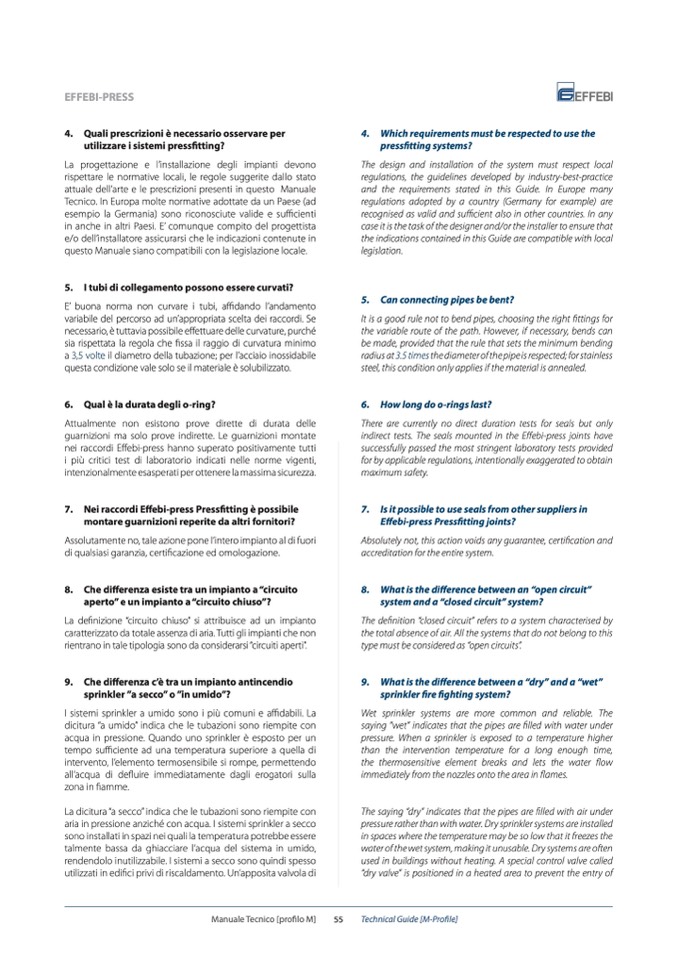
EFFEBI-PRESS
4. Quali prescrizioni è necessario osservare per
utilizzare i sistemi pressfitting?
La progettazione e l’installazione degli impianti devono
rispettare le normative locali, le regole suggerite dallo stato
attuale dell’arte e le prescrizioni presenti in questo Manuale
Tecnico. In Europa molte normative adottate da un Paese (ad
esempio la Germania) sono riconosciute valide e su
fficienti
in anche in altri Paesi. E’ comunque compito del progettista
e/o dell’installatore assicurarsi che le indicazioni contenute in
questo Manuale siano compatibili con la legislazione locale.
5. I tubi di collegamento possono essere curvati?
E’ buona norma non curvare i tubi, affidando l’andamento
variabile del percorso ad un’appropriata scelta dei raccordi. Se
necessario, è tuttavia possibile effettuare delle curvature, purché
sia rispettata la regola che fissa il raggio di curvatura minimo
a 3,5 volte il diametro della tubazione; per l’acciaio inossidabile
questa condizione vale solo se il materiale è solubilizzato.
6. Qual è la durata degli o-ring?
Attualmente non esistono prove dirette di durata delle
guarnizioni ma solo prove indirette. Le guarnizioni montate
nei raccordi Effebi-press hanno superato positivamente tutti
i più critici test di laboratorio indicati nelle norme vigenti,
intenzionalmente esasperati per ottenere la massima sicurezza.
7. Nei raccordi Effebi-press Pressfitting è possibile
montare guarnizioni reperite da altri fornitori?
Assolutamente no, tale azione pone l’intero impianto al di fuori
di qualsiasi garanzia, certificazione ed omologazione.
8. Che differenza esiste tra un impianto a “circuito
aperto” e un impianto a “circuito chiuso”?
La definizione “circuito chiuso” si attribuisce ad un impianto
caratterizzato da totale assenza di aria. Tutti gli impianti che non
rientrano in tale tipologia sono da considerarsi “circuiti aperti”.
9. Che differenza c’è tra un impianto antincendio
sprinkler ”a secco” o ”in umido”?
I sistemi sprinkler a umido sono i più comuni e affidabili. La
dicitura “a umido” indica che le tubazioni sono riempite con
acqua in pressione. Quando uno sprinkler è esposto per un
tempo sufficiente ad una temperatura superiore a quella di
intervento, l’elemento termosensibile si rompe, permettendo
all’acqua di defluire immediatamente dagli erogatori sulla
zona in fiamme.
La dicitura “a secco” indica che le tubazioni sono riempite con
aria in pressione anziché con acqua. I sistemi sprinkler a secco
sono installati in spazi nei quali la temperatura potrebbe essere
talmente bassa da ghiacciare l’acqua del sistema in umido,
rendendolo inutilizzabile. I sistemi a secco sono quindi spesso
utilizzati in edifici privi di riscaldamento. Un’apposita valvola di
4. Which requirements must be respected to use the
pressfitting systems?
The design and installation of the system must respect local
regulations, the guidelines developed by industry-best-practice
and the requirements stated in this Guide. In Europe many
regulations adopted by a country (Germany for example) are
recognised as valid and sufficient also in other countries. In any
case it is the task of the designer and/or the installer to ensure that
the indications contained in this Guide are compatible with local
legislation.
5. Can connecting pipes be bent?
It is a good rule not to bend pipes, choosing the right fittings for
the variable route of the path. However, if necessary, bends can
be made, provided that the rule that sets the minimum bending
radius at 3.5 times the diameter of the pipe is respected; for stainless
steel, this condition only applies if the material is annealed.
6. How long do o-rings last?
There are currently no direct duration tests for seals but only
indirect tests. The seals mounted in the Effebi-press joints have
successfully passed the most stringent laboratory tests provided
for by applicable regulations, intentionally exaggerated to obtain
maximum safety.
7. Is it possible to use seals from other suppliers in
Effebi-press Pressfitting joints?
Absolutely not, this action voids any guarantee, certification and
accreditation for the entire system.
8. What is the difference between an “open circuit”
system and a “closed circuit” system?
The definition “closed circuit” refers to a system characterised by
the total absence of air. All the systems that do not belong to this
type must be considered as “open circuits”.
9. What is the difference between a “dry” and a “wet”
sprinkler fire fighting system?
Wet sprinkler systems are more common and reliable. The
saying “wet” indicates that the pipes are filled with water under
pressure. When a sprinkler is exposed to a temperature higher
than the intervention temperature for a long enough time,
the thermosensitive element breaks and lets the water flow
immediately from the nozzles onto the area in flames.
The saying “dry” indicates that the pipes are filled with air under
pressure rather than with water. Dry sprinkler systems are installed
in spaces where the temperature may be so low that it freezes the
water of the wet system, making it unusable. Dry systems are often
used in buildings without heating. A special control valve called
“dry valve” is positioned in a heated area to prevent the entry of
Manuale Tecnico [profilo M]
55
Technical Guide [M-Profile]

